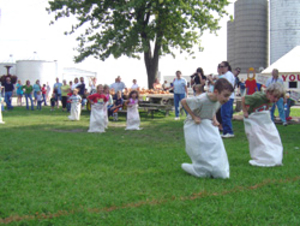Possessive aggressive behavior is a learned reaction to having a favorite toy, food or bed taken away and not replaced. It is also a means of controlling the environment [through aggressive behavior] because it has worked in the past to maintain a desired hierarchical position.
This behavior is very common in dogs that have been abandoned, lost or merely allowed to control the household. In the case of the lost or abandoned dog the behavior is to protect a food source or resting area from another animal. Without this behavioral development the dog is likely to go without food and a place to sleep, decreasing the chances for survival, so it is a natural, instinctive reaction to this situation.
In the case of the dog who runs the household, these behaviors are not necessary for survival, but have developed due to the dog feeling the need to lead and distrusting the other house-mates to do an appropriate job of protecting the territory. This territory often encompasses the sleeping area, food dishes or specific toys; sometimes all of them.
While there are trainers who would punish the dog using harsh collar corrections, yelling, pinching or other negative and harmful training methods, there is an easy way to overcome this behavior using positive reinforcement.
Here’s how:
The first step is to remain calm at all times. Don’t become anxious, or raise your voice and, above all, be patient.
The next, and most important step, is to make your dog earn everything. Most pet dogs who are possessive aggressive have always had plenty of resources handed to them for free, so they haven’t learned how to earn anything, as they would if living in the wild. This is the “Nothing is Free” concept, intrinsic to curing most bad canine behaviors. As a dog learns to perform specific behaviors to receive his resources, he’ll no longer be aggressive about them as that doesn’t help him obtain them.
Dogs, as with all animals, seek a reward of some sort for everything they do. Without this learning process they wouldn’t live normal life spans. The possessive aggressive dog is rewarded by controlling and keeping his resources. Take away that free access and the dog has to change his attitude, quickly.
Let’s take an example of a favorite toy. The possessive aggressive dog, let’s call him Sparky, will attack anyone who touches it or even gets near it, never mind trying to take it away. That’s a sure bite. This dog has learned to manipulate those in his family pack. He does so through intimidation. Most assuredly the others have learned to not challenge Sparky, as they’ve already experienced his wrath, making them hesitant and fearful. Sparky further feeds on their reactions which encourages his own behavior for it is rewarding him as the pack leader. Dogs will repeat rewarded behavior.
So we begin the process by sneaking away the toy when Sparky is otherwise engaged – sleeping, eating or outside. We will also take away his free meals. He’ll be earning them by displaying appropriate behavior responses through trial and error. At first it seems interminable as far as how long it takes Sparky to figure out what you want. As his teacher you must be aware of every little step he accomplishes toward the overall goal.
Further break down the goal into many minor achievable goals, which will quickly build Sparky’s repertoire and cooperation, with few, if any, negative reactions or outbursts involved. This type of training usually achieves a goal without the dog becoming irritated enough to bite. In fact, most dogs love to learn and once inducted into this process look forward to their next lesson.
Begin by saying your dog’s name and making a unique sound when he looks at you. Once you make that sound (let’s call that a marker), give him a food morsel or treat. If your dog loves his regular food, using it for training is preferable to a high fat, low nutrient treat. This will also help in maintaining his optimum weight as no extra calories are added to his diet.
When your dog readily looks at you when you say his name, mark quickly and feed quickly. He’s now ready for the next step.
Hold the object of his possessiveness in one hand. If he looks at the object calmly, mark and reward him. If he begins to get assertive, take it away from his view and ignore him. Repeat this until your dog is calmly looking at his toy or you without any assertive behavior.
Next hold the toy a little lower. Gradually allow the toy to get closer to your dog as he remains calm. The moment he becomes assertive reverse your process to where he was watching calmly and work at that level a little longer. Sometimes moving through the steps too quickly will make the dog more anxious about his toy. Whereas taking your time and rewarding each little step is far more productive.
As you are able to allow your dog close proximity to the toy, it is time for the next step: Letting him touch it. You can turn this step into a game, by rewarding him each time he touches it with his nose. This not only teaches him to allow you to hold it and not try grabbing it from you, but also to target on an object of your choosing, furthering his education into other directions.
When your dog is readily touching his toy, then turning to you to hear his marker and receive his reward you can then lay the toy on the floor and repeat the exercise. If your dog suddenly grabs and runs with his toy he wasn’t ready for this step. If he returns to targeting on the toy and looking to you for the reward, he was certainly ready.
If you are at all uncertain of his readiness, tie a light rope to the toy so that you can retrieve it from your dog without getting your hands near his face, which is very threatening to him when he’s in a highly aroused state of mind.
If your dog was ready for this step and is looking to you for his rewards instead of self-rewarding by taking the toy, you can begin taking the toy, marking his good behavior and returning the toy, again marking his good behavior.
At this point, Sparky has learned that his rewards come from you, not from his own assertive behavior and he will begin performing all sorts of new positive behaviors to earn your approval instead of forcing you into earning his approval.
Best of all, using these positive training methods helped the two of you become best friends again, without having to undergo any negative confrontation at any time. All it took was a little time and patience.
Regardless of the object of your dog’s possessive behavior these methods can be utilized to cure it and move your dog into a positive direction in every aspect of his life, and yours.





